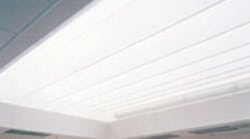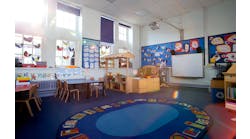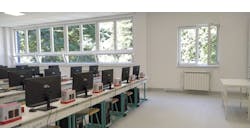When the subject of buildings and daylighting arises, most people’s thoughts will turn first to windows. To the uninitiated, it seems a simple formula: more windows, more daylight; fewer windows, less daylight.
But designers know that effective use of daylighting in a building design involves more than just letting in light to otherwise darkened spaces. Too much daylight, especially the glare of direct sunlight, can be as undesirable as too little daylight. Daylighting also affects how much heat enters a facility; the benefits of natural light quickly can be outweighed when the heat that comes with it creates a space uncomfortable to occupants.
When the building in question is a school or university, the importance of effective daylighting strategies becomes even more critical. A classroom with good daylighting design can help students boost their academic performance, studies have shown.
So for designers of education facilities, decisions about windows go beyond the question of quantity. Where in the space should windows be placed? In the ceiling? Along the walls? How high on the wall? Which walls? What kinds of window glazing should be used? How large should the aperture of each window be? Will the windows need shading devices? Will louvers or baffles be necessary to help control how much light enters the space? How does the size and shape of each space, and the footprint and orientation of the building as a whole affect where windows should be situated?
By determining how each of these decisions affects the lighting in learning spaces and the energy costs of heating and cooling the building, schools and universities can construct energy-efficient education facilities illuminated with ample daylight.
Taking another view
The windows that provide views from a classroom to the outdoors are not the ones that bring about effective daylighting. Schools should develop their daylighting designs with "roof monitors; high, south-side light-shelf apertures; or high, north glass transom windows," according to the Guide for Daylighting Schools.
Daylight Dividends, a national research program of the U.S. Department of Energy and other agencies, advocates for the incorporation of daylighting strategies in building designs. It commissioned Innovative Design, an architectural firm in Raleigh, N.C., that specializes in sustainable design, to put together the Guide for Daylighting Schools.
Roof monitors—raised sections of a roof with vertical glazing—should be considered first in putting together a daylighting design, as long as the school that is being planned is a one-story facility. Monitors with south-facing glazing, properly sized overhangs and interior baffles to diffuse the light provide the most daylighting benefits. Roof monitors create uniform lighting throughout a space, eliminate contrast and glare, bring natural light to spaces far from the perimeter of the building, and allow more heat to enter the building in colder months.
South-facing light shelves are considered the next best daylighting option, according to the guide. Light shelves are horizontal surfaces that deflect sunlight coming through windows toward the ceiling to spread diffused light throughout a room. Light shelves can be used in multi-story buildings and typically cost less than roof monitors, the guide says. But because the light is coming from just one side of a space, achieving uniform lighting is more difficult.
North-facing monitors provide daylighting benefits, but are not as energy-efficient as those that face south. They typically require at least 25 percent more glazing to achieve the same annual daylighting contribution, the guide says.
"The best way to design the size of daylighting apertures is to size the glazing and overhangs so that just the right amount of radiation is brought into the school during the summer peak cooling condition," the guide says. "If the glazing is south-facing, this strategy will allow more and more radiation to enter the space as fall becomes winter."
Let it in
In pursuit of energy efficiency, many schools have windows with low-E coatings, which help keep unwanted heat out of classrooms in warm weather, and keep heat in the classrooms when outside temperatures are frigid. Low-E coatings are beneficial for view windows, but may be counterproductive for windows that are part of the daylighting strategy.
But for windows meant for bringing daylight into a space, clear glass has advantages over glazing with low-E coatings, the guide says. Low-E coatings reduce the transmission of visible light by 10 to 30 percent, so a window opening would have to be 10 to 30 percent larger to provide the same amount of daylight. That would bring greater amounts of unwanted heat gain to the room.
"To effectively address energy at the same time you are creating a good daylighting strategy, it is important to minimize the size and maximize the transmission of daylighting apertures," the guide says.
More tips
The Daylighting Collaborative, created by the Energy Center of Wisconsin to encourage incorporating natural light in facilities design, offers tips for carrying out daylighting strategies:
•Don’t do daylighting without controls to manage the electric lighting levels.
•Understand that daylighting is a systems approach. Failure to consider one element can seriously compromise a design.
•Make sure that the design team understands the benefits of daylighting and supports the approach; don’t let those with a shortsighted view value engineer the daylighting controls out of a project.
•Basic software and training can provide daylighting design rules and strategies. In many parts of the country, the Collaborative notes, technical assistance support is available to help analyze a design.
•Read the sidebar "Daylighting and LEED" to learn more about the Daylighting Collaborative's tips for earning LEED points.
Kennedy, staff writer, can be reached at [email protected].
Daylighting and LEED
Effective daylighting will enable a building to use less energy, so it is no surprise that incorporation of the strategy is a key factor in the U.S. Green Building Council’s Leadership in Energy and Environmental Design (LEED) rating system.
According to the Daylighting Collaborative, a building can earn points for daylighting design in four of the six LEED categories:
•Indoor environmental quality. A design can receive LEED points for daylighting strategies that give occupants a view to the outdoors and that provide individuals with the ability to adjust lighting levels for specific circumstances.
•Energy and atmosphere. Good daylighting design can significantly reduce energy use of lighting and HVAC systems.
•Materials and resources. Many products used in daylighting design can help meet recycled content goals, the Collaborative says.
•Innovation and design process. A design that integrates daylighting strategies effectively can receive points for innovation.



